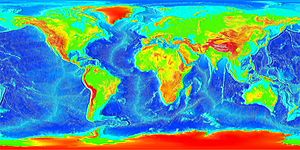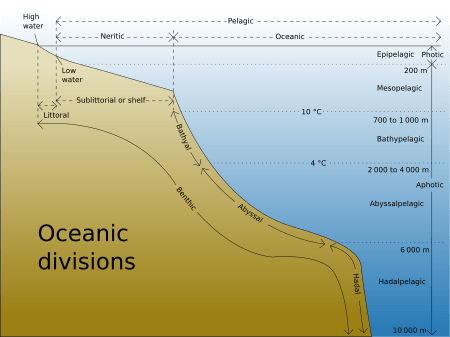Seabed facts for kids
The seabed is simply the bottom of the ocean. You might also hear it called the seafloor or ocean floor. It's like the land we live on, but it's hidden deep underwater! The seabed has many different features, including huge mountains, deep valleys, and wide, flat plains.
Contents
How the Seabed is Formed
Most oceans have a similar structure. This is mainly because of how tectonic plates move and how sediment builds up. Tectonic plates are huge pieces of the Earth's outer layer that are always slowly moving.
From Land to Deep Ocean
Starting from the land, the ocean floor usually begins with a continental shelf. This is a gently sloping area of seabed that extends out from a continent. It's like a shallow underwater ledge.
Next, you'll find the continental slope. This is a much steeper drop-off, like a big hill going down into the ocean.
At the bottom of the continental slope, the seabed becomes flatter. This area is called the abyssal plain. It's a very flat, wide area that makes up most of the deep ocean floor.
Between the continental slope and the abyssal plain, there's often a gentler slope called the continental rise. This area is formed by sediment that slides down the steep continental slope and settles at the bottom.
Underwater Mountains and Valleys
Imagine a huge mountain range running through the middle of all the oceans. This is called the mid-ocean ridge. It's where new ocean floor is created as tectonic plates pull apart. A deep crack, called a rift, often runs along the top of this ridge.
Where tectonic plates push together, you often find oceanic trenches. These are very deep, narrow valleys in the ocean floor. They are the deepest parts of the ocean. These trenches are formed as one plate slides under another.
Hotspots and Vents
Sometimes, volcanoes erupt in the middle of a tectonic plate, far from the edges. These are called hotspot volcanoes. As the plate moves over the hotspot, a chain of volcanic islands can form.
In areas with volcanic activity and in the deep oceanic trenches, you can find hydrothermal vents. These are like chimneys on the seabed that release extremely hot water and chemicals. This water is super-heated deep within the Earth. Even though the surrounding ocean water is freezing, special life forms thrive around these vents!

Ocean Zones by Depth
The deep ocean water is divided into different layers or zones. Each zone has its own typical features, like how salty it is, how much pressure there is, its temperature, and the types of sea creatures that live there.
- The abyssal zone is the area just above the abyssal plain. It goes down to about 6,000 meters (20,000 feet) deep.
- The hadal zone is the deepest part of the ocean. It includes the oceanic trenches and goes from 6,000 to 11,000 meters (20,000 to 36,000 feet) deep. It's one of the most extreme environments on Earth!
Images for kids
-
Different types of sediment from the Southern Ocean. You can see various sizes of grains: A) gravel and sand, B) gravel, C) mud and sand mixed by living creatures, and D) layered clays and silts.
-
Map of the underwater shape of the ocean floor (from 1995 NOAA).
See also
 In Spanish: Relieve oceánico para niños
In Spanish: Relieve oceánico para niños













